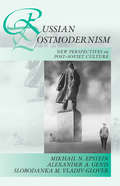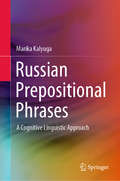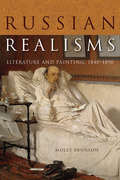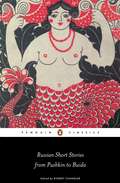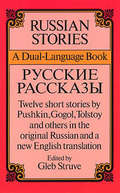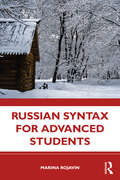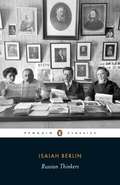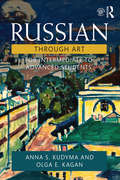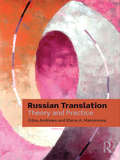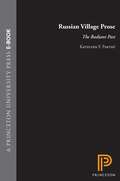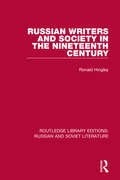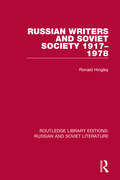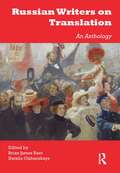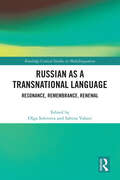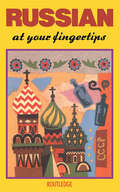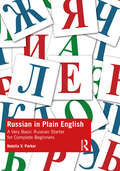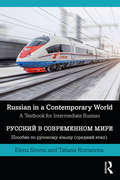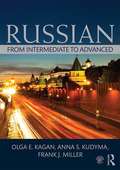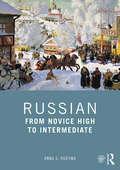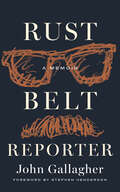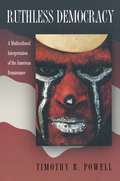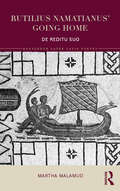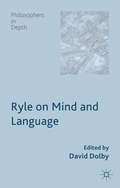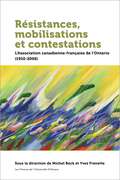- Table View
- List View
Russian Postmodernism
by Mikhail N. Epstein Alexander A. Genis Slobodanka Millicent Vladiv-GloverRecent decades have been decisive for Russia not only politically but culturally as well. The end of the Cold War has enabled Russia to take part in the global rise and crystallization of postmodernism. This volume investigates the manifestations of this crucial trend in Russian fiction, poetry, art, and spirituality, demonstrating how Russian postmodernism is its own unique entity. It offers a point of departure and valuable guide to an area of contemporary literary-cultural studies insufficiently represented in English-language scholarship. This second edition includes additional essays on the topic and a new introduction examining the most recent developments.
Russian Prepositional Phrases: A Cognitive Linguistic Approach
by Marika KalyugaThe book presents a comprehensive study of Russian prepositions, with a focus on expressing spatial characteristics. It primarily deals with how metaphorical and metonymical transfers motivate the use of Russian prepositional phrases, explaining the collocations of prepositional phrases with verbs as a realisation of a conceptual metaphor or a metonymy. The author confronts a problem that is attracting growing attention within present-day linguistics: the semantics of prepositions and cases. The book seeks to clarify the conceptual motivations for the use of the combinations of Russian primary prepositional phrases, as well as to demonstrate how their spatial meanings are extended into non-spatial domains. This book incorporates an analysis of a large number of items, including 30 combinations of primary prepositions with cases. An original contribution, the book is of interest to teachers and students studying Slavic languages, and to cognitive linguists.
Russian Realisms: Literature and Painting, 1840–1890 (NIU Series in Slavic, East European, and Eurasian Studies)
by Molly BrunsonOne fall evening in 1880, Russian painter Ilya Repin welcomed an unexpected visitor to his home: Lev Tolstoy. The renowned realists talked for hours, and Tolstoy turned his critical eye to the sketches in Repin's studio. Tolstoy's criticisms would later prompt Repin to reflect on the question of creative expression and conclude that the path to artistic truth is relative, dependent on the mode and medium of representation. In this original study, Molly Brunson traces many such paths that converged to form the tradition of nineteenth-century Russian realism, a tradition that spanned almost half a century—from the youthful projects of the Natural School and the critical realism of the age of reform to the mature masterpieces of Tolstoy, Fyodor Dostoevsky, and the paintings of the Wanderers, Repin chief among them. By examining the classics of the tradition, Brunson explores the emergence of multiple realisms from the gaps, disruptions, and doubts that accompany the self-conscious project of representing reality. These manifestations of realism are united not by how they look or what they describe, but by their shared awareness of the fraught yet critical task of representation. By tracing the engagement of literature and painting with aesthetic debates on the sister arts, Brunson argues for a conceptualization of realism that transcends artistic media. Russian Realisms integrates the lesser-known tradition of Russian painting with the familiar masterpieces of Russia's great novelists, highlighting both the common ground in their struggles for artistic realism and their cultural autonomy and legitimacy. This erudite study will appeal to scholars interested in Russian literature and art, comparative literature, art history, and nineteenth-century realist movements.
Russian Short Stories from Pushkin to Buida
by Robert ChandlerFrom the reign of the Tsars in the early 19th century to the collapse of the Soviet Union and beyond, the short story has long occupied a central place in Russian culture. Included are pieces from many of the acknowledged masters of Russian literature - including Pushkin, Turgenev, Dostoyevsky, Tolstoy, and Solzhenitsyn - alongside tales by long-suppressed figures such as the subversive Kryzhanowsky and the surrealist Shalamov. Whether written in reaction to the cruelty of the bourgeoisie, the bureaucracy of communism or the torture of the prison camps, they offer a wonderfully wide-ranging and exciting representation of one of the most vital and enduring forms of Russian literature.
Russian Stories: A Dual-Language Book (Dover Dual Language Russian)
by Gleb StruveThe story, or novella, as a literary genre has a much shorter history in Russia than in some Western countries, but it has nevertheless produced important works by some of the greatest names in Russian literature. This dual-language volume contains 12 such stories — memorable tales by Tolstoy, Dostoevsky, Pushkin, Chekhov, Gogol, Turgenev, Bunin, and other masters. Each selection is presented here in the original Russian with an excellent literal English translation on the facing pages.Also included are linguistic and cultural notes, a Russian-English vocabulary, study questions and more. In addition, Professor Struve has supplied an enlightening introduction to the Russian short story, as well as concise biographical/critical introductions to each selection. An especially helpful feature for students of Russian is the presence of stress accents in the Russian text, a feature usually found only in primers.
Russian Syntax for Advanced Students
by Marina RojavinRussian Syntax for Advanced Students is a textbook which illuminates relationships between words, phrases, clauses, and sentences. Using this book, students will acquire conscious knowledge of how words function in various syntactical constructions as applied to discourse, such as specific verbal situations, based not only on the underlying linguistic phenomena, but also on the content of sociolinguistic situations. The book helps develop communicative skills for advanced mastery and constantly emphasizes the importance of accuracy in the use of syntactic structures. Russian Syntax is designed primarily as a textbook for classroom use for intermediate-high and advanced-level students. The text is also suitable for independent study by graduate students in linguistics or pedagogy, as well as being a valuable reference for instructors.
Russian Thinkers
by Isaiah BerlinFew, if any, English-language critics have written as perceptively as Isaiah Berlin about Russian thought and culture. Russian Thinkers is his unique meditation on the impact that Russia's outstanding writers and philosophers had on its culture. In addition to Tolstoy's philosophy of history, which he addresses in his most famous essay, 'The Hedgehog and the Fox,' Berlin considers the social and political circumstances that produced such men as Herzen, Bakunin, Turgenev, Belinsky, and others of the Russian intelligentsia, who made up, as Berlin describes, 'the largest single Russian contribution to social change in the world.'
Russian Through Art: For Intermediate to Advanced Students
by Olga E. Kagan Anna S. KudymaRussian Through Art: For Intermediate to Advanced Students develops all four language skills while enhancing students’ cultural knowledge through exposure to Russian visual arts. Each of the six thematically organised chapters is accompanied by online resources, available at https://ccle.ucla.edu/course/view/russnart. These supporting materials include online lectures, readings, audio and video clips and assignments of varying levels of difficulty, starting with description and narration tasks and progressing to discussion and debate. Each chapter contains a number of task-based and project-based assignments. The book and website’s modular design make it easy to adapt this comprehensive resource to different course needs and different levels. By the end of the course students will have broadened their active vocabulary, enhanced their grammatical skills while familiarising themselves with Russian art in its various representations and periods.
Russian Translation: Theory and Practice
by Edna Andrews Elena MaksimovaRussian Translation: Theory and Practice is a comprehensive practical course in translation for advanced undergraduate and postgraduate students of Russian. The course aims to provide intensive exposure with a view to mastering translation from Russian into English while carefully analyzing the specific problems that arise in the translation process. Offering over 75 practical translation exercises and texts analyzed in detail to illustrate the stage-by-stage presentation of the method, Russian Translation addresses translation issues such as cultural differences, genre and translation goals. The book features material taken from a wide range of sources, including: journalistic medical scholarly legal economic popular culture – literature (prose and poetry), media, internet, humour, music. Central grammatical and lexical topics that will be addressed across the volume through the source texts and target texts include: declensional and agreement gender; case usage; impersonal constructions; verbal aspect; verbal government; word order; Russian word formation, especially prefixation and suffixation; collocations and proverbs; and abbreviations. Russian Translation: Theory and Practice is essential reading for all students seriously interested in improving their translation skills. A Tutor’s Handbook for this course, giving guidance on teaching methods and assessment, as well as specimen answers, is available in PDF format from our website at http://www.routledge.com/books/Russian-Translation-isbn9780415473477. Edna Andrews is Professor of Linguistics and Cultural Anthropology, Director of the Center for Slavic, Eurasian and East European Studies at Duke University, USA. Elena Maksimova is Associate Professor of the Practice in the Department of Slavic and Eurasian Studies at Duke University, USA.
Russian Village Prose: The Radiant Past
by Kathleen F. ParthéKathleen Parth offers the first comprehensive examination of the controversial literary movement Russian Village Prose. From the 1950s to the decline of the movement in the 1970s, Valentin Rasputin, Fedor Abramov, and other writers drew on "luminous" memories of their rural childhoods to evoke a thousand-year-old pattern of life that was disappearing as they wrote. In their lyrical descriptions of a vanishing world, they expressed nostalgia for Russia's past and fears for the nation's future; they opposed collectivized agriculture, and fought to preserve traditional art and architecture and to protect the environment. Assessing the place of Village Prose in the newly revised canon of twentieth-century Russian literature, Parth maintains that these writers consciously ignored and undermined Socialist Realism, and created the most aesthetically coherent and ideologically important body of published writings to appear in the Soviet Union between Stalin's death and Gorbachev's ascendancy. In the 1970s, Village Prose was seen as moderately nationalist and conservative in spirit. After 1985, however, statements by several of its practitioners caused the movement to be reread as a possible stimulus for chauvinistic, anti-Semitic groups like Pamyat. This important development is treated here with a thorough discussion of all the political implications of these rural narratives. Nevertheless, the center of Parth's work remains her exploration of the parameters that constitute a "code of reading" for works of Village Prose. The appendixes contain a translation and analysis of a particularly fine example of Russian Village Prose--Aleksei Leonov's "Kondyr."
Russian Writers and Society in the Nineteenth Century (Routledge Library Editions: Russian and Soviet Literature #13)
by Ronald HingleyThis book, first published in 1977, begins with a close look at the lives of nineteenth century Russian writers, and at the problems of their profession. It then examines their environment in its broader aspects, the Russian empire being considered from the point of view of geography, ethnography, economics, and the impact of individual Tsars on writers and society. A discussion of the main social ‘estates’ follows, and concluding is an analysis in their literary context of the activities of the competing forces of cohesion and disruption in imperial society: the civil service, law courts, police, army, schools, universities, press, censorship, revolutionaries and agitators. This book makes possible a fuller understanding of the works of Pushkin, Dostoyevsky, Chekhov and the other great Russian writers.
Russian Writers and Soviet Society 1917–1978 (Routledge Library Editions: Russian and Soviet Literature #14)
by Ronald HingleyThis book, first published in 1979, provides a systematic anatomy of Russia’s modern authors in the context of their society at the time. Post-revolutionary Russian literature has made a profound impact on the West while still maintaining its traditional role as a vehicle for political struggle at home. Professor Hingley places their lives and work firmly in the setting of the USSR’s social and political structure.
Russian Writers on Translation: An Anthology
by Brian James Baer Natalia OlshanskayaSince the early eighteenth century, following Peter the Great’s policy of forced westernization, translation in Russia has been a very visible and much-discussed practice. Generally perceived as an important service to the state and the nation, translation was also viewed as a high art, leading many Russian poets and writers to engage in literary translation in a serious and sustained manner. As a result, translations were generally regarded as an integral part of an author’s oeuvre and of Russian literature as a whole. This volume brings together Russian writings on translation from the mid-18th century until today and presents them in chronological order, providing valuable insights into the theory and practice of translation in Russia. Authored by some of Russia’s leading writers, such as Aleksandr Pushkin, Fedor Dostoevskii, Lev Tolstoi, Maksim Gorkii, and Anna Akhmatova, many of these texts are translated into English for the first time. They are accompanied by extensive annotation and biographical sketches of the authors, and reveal Russian translation discourse to be a sophisticated and often politicized exploration of Russian national identity, as well as the nature of the modern subject. Russian Writers on Translation fills a persistent gap in the literature on alternative translation traditions, highlighting the vibrant and intense culture of translation on Europe’s ‘periphery’. Viewed in a broad cultural context, the selected texts reflect a nuanced understanding of the Russian response to world literature and highlight the attempts of Russian writers to promote Russia as an all-inclusive cultural model.
Russian as a Transnational Language: Resonance, Remembrance, Renewal (Routledge Critical Studies in Multilingualism)
by Solovova, Edited by OlgaThis collection contributes to emerging work in critical sociolinguistics, using a multidisciplinary and multiscalar approach to understanding the diasporic experience in the Russian-speaking world. The volume expands on research in the sociolinguistics of mobility, multilingualism, and diaspora studies. It critically examines the ways in which transnational Russian identities are perceived and discursively enacted in online and offline spaces, and how this interplay contributes to diasporic identification across the globe. In highlighting a range of critical methodologies at multiple scalar levels − across family, national, and global lines − the book raises key questions about what binds and distinguishes individuals belonging to diverse communities of Russian speakers. It likewise interrogates established notions of memory, nostalgia, authenticity, and belonging, as well as perceptions of futurity and change. This book will be of particular interest to students and scholars in sociolinguistics, multilingualism, language and education, and linguistic anthropology.
Russian at your Fingertips (The Fingertips Series)
by LexusFirst published in 1990. Routledge is an imprint of Taylor & Francis, an informa company.
Russian in Plain English: A Very Basic Russian Starter for Complete Beginners
by Natalia V. ParkerRussian in Plain English enables complete beginners to acquire the skill of reading words written in Cyrillic independently, with no English transcription or imitated pronunciation, within a short period of time. This book introduces the Cyrillic alphabet gradually, feeding in the letters and their various pronunciation aspects one by one over its ten units, thus building a complete picture of the Russian sound and writing systems. It also highlights the interrelationship of the two systems and helps learners to see the logic behind the use of the Cyrillic alphabet. In addition, the book teaches learners to produce Russian word stress on a marked syllable, contributing to stress acquisition. Furthermore, the book explains the basic grammatical features of Russian words and the rules of how to put them into sentences, enabling learners to start saying things in Russian from Unit 1. It employs some findings of research in language processing, helping learners to start building their speaking and reading skills. This book is an essential guide for all beginners, including students and independent learners.
Russian in a Contemporary World: A Textbook for Intermediate Russian
by Elena Simms Tatiana RomanovaRussian in a Contemporary World is an intermediate textbook with a focus on improving oral and written skills of the Russian language by encouraging students’ creative potential with their use of language in a contemporary society, such as media, TV, art, and technology. Key features of the textbook include: Use of original texts and application of material by choosing topics which reflect the students’ general interests, according to a survey conducted among Humanities undergraduates and which are essential for students of Russian language, culture, and society; Practical skills: the textbook allows students to process primary text sources, summarising, writing, and expressing their views on certain sociopolitical issues; Raises issues which are being widely discussed in present-day Russia and introduces trends in the development of modern Russian society; Providing feedback: students can check their work against answer keys that feature in a number of exercises as well as find discussions on different grammatical topics in the Appendix. Aimed at B1-B2 and Intermediate-Mid students of Russian, this is the ideal textbook for those aiming to improve their Russian whilst gaining knowledge of contemporary Russian culture and society. With answer keys and grammar topics included, the textbook is also ideal for independent study.
Russian: From Intermediate to Advanced
by Olga E. Kagan Frank J. Miller Kudyma AnnaRussian: From Intermediate to Advanced is a vibrant and modern course designed to help students achieve advanced proficiency in Russian. Offering a flexible modular approach structured around contemporary themes, the course further develops reading, listening, speaking, and writing skills while also expanding the student’s cultural literacy. Key features include: Structured chapters presenting a wide assortment of readings that include blogs, forums and surveys as well as opinion pieces and commentaries. Each text is accompanied by assignments with increasing levels of difficulty. Authentic and up-to-date readings, video and audio excerpts covering a range of relevant social and cultural topics, including Demography, Youth Culture, Politics and Society, Economics and Globalization. Video clips from news programs that are used not only to develop listening comprehension but also introduce students to contemporary Russian society. Particular attention to helping students acquire advanced vocabulary and the ability to converse, discuss and argue about issues with extended paragraph-length discourse. Special focus on the development of strong listening and reading comprehension skills, ensuring that students understand the ideas and supporting details in narrative and descriptive texts and connected discourse. A free companion website at http://www.russian.ucla.edu/AdvancedRussian/ offering student and instructor video and audio resources, sample syllabi and tests as well as additional materials. Written by a highly experienced author team that has co-authored the first year Russian textbook Beginner’s Russian (2010) and the second-year textbook V Puti (2005). Russian: From Intermediate to Advanced will be an essential resource for undergraduate students in their third and fourth year of Russian language study. It is also suitable for heritage learners of Russian who have mastered literacy and are familiar with the grammatical structure of Russian.
Russian: From Novice High to Intermediate
by Anna S. KudymaRussian: From Novice High to Intermediate is a multi-level course that presents grammar, vocabulary, culture, music, film, and literature within the context of Russian life. With a flexible modular approach structured around contemporary themes, this course builds on students’ reading, listening, speaking, and writing skills while also expanding their cultural literacy. Each chapter contains projects and scenarios that enable language learners to practice and demonstrate communicative competence. An interactive website full of videos, audio, and self-correcting exercises accompanies the course and can be accessed through www.routledge.com/9780367137137. This comprehensive resource is ideal for use in second- and third-year Russian classes.
Rust Belt Reporter: A Memoir (Great Lakes Books)
by John GallagherThe decline and resurgence of a storied Midwestern city as seen through the eyes of a seasoned journalist, union activist, and Detroit devotee. Reflecting on his life's work as a reporter, including thirty-two years with the Detroit Free Press, journalist John Gallagher merges memoir with an insider's account of the challenges facing Detroit and other Rust Belt cities, as well as the tensions inside local newsrooms throughout the country. Beginning with Gallagher's first job in 1974 in Chicago, with subsequent stops in Rochester and Syracuse, New York, this witty and exciting chronicle details his experiences behind the scenes, breaking major news stories over the decades that followed. From the early days when reporters called in stories on pay phones to today's revenue-generating affiliate commissions, his memoir serves as a documentary of this turbulent journalistic era. Gallagher's career intersected many notable events, including the troubled Kilpatrick administration, newspaper strikes, the federal bailout of automotive companies, the bankruptcy of Detroit, and the exceptional Grand Bargain struck to save the city—all while noting the increasingly important roles nonprofits and private companies play in city politics and newsrooms, for better and for worse. Alongside sage insight into the difficulties and decline of traditional media, Gallagher's experience and advice inspire hope, often underscoring and celebrating the surprising and happy reinvention of heartland cities like Detroit.
Ruthless Democracy: A Multicultural Interpretation of the American Renaissance
by Timothy B. PowellIn Ruthless Democracy, Timothy Powell reimagines the canonical origins of "American" identity by juxtaposing authors such as Hawthorne, Melville, and Thoreau with Native American, African American, and women authors. Taking his title from Melville, Powell identifies an unresolvable conflict between America's multicultural history and its violent will to monoculturalism. Powell challenges existing perceptions of the American Renaissance--the period at the heart of the American canon and its evolutions--by expanding the parameters of American identity. Drawing on the critical traditions of cultural studies and new historicism, Powell invents a new critical paradigm called "historical multiculturalism." Moving beyond the polarizing rhetoric of the culture wars, Powell grounds his multicultural conception of American identity in careful historical analysis. Ruthless Democracy extends the cultural and geographical boundaries of the American Renaissance beyond the northeast to Indian Territory, Alta California, and the transnational sphere that Powell calls the American Diaspora. Arguing for the inclusion of new works, Powell envisions the canon of the American Renaissance as a fluid dialogue of disparate cultural voices.
Rutilius Namatianus' Going Home: De Reditu Suo (Routledge Later Latin Poetry)
by Martha MalamudMartha Malamud provides the only scholarly English translation of De Reditu Suo with significant notes and commentary that explore historical, literary, cultural, and mythical references, as well as commenting on literary allusions, the structure, diction, and style of the poem, and textual issues. De Reditu Suo provides fascinating insights into travel and communications networks in the rapidly changing, fragmented world of the fifth century. A substantial introductory essay explores Rutilius’ place in several intellectual and literary traditions, as the poem is a sophisticated piece of literature that both draws on the rich tradition of classical Latin poetry and reflects the distinctive formal features of late antique poetry. The poem also conveys the thoughts of a man passionately devoted to Rome and its cultural heritage, enmeshed in the tumultuous political and social upheaval of his day, caught between his hopes for Rome’s restoration and his fear of its disintegration. With line-for-line translation from the Latin and a scholarly introduction, extensive notes, and comprehensive bibliography, Martha Malamud makes this important text accessible and relevant for students and scholars in Classics, Comparative Literature, Religious Studies, Medieval Studies, and Ancient History, as well as independent readers with an interest in the literature of the period.
Ryle on Mind and Language
by David DolbyThis collection is devoted to Gilbert Ryle's philosophy of mind and language. It features essays from prominent scholars on the topics of category mistakes, hypotheticals, dispositions, emotion, thinking, perception, and the task-achievement distinction.
Résistances, mobilisations et contestations: L’Association canadienne-française de l’Ontario (1910-2006) (Amérique française)
by Michel Bock et Yves FrenetteL’Association canadienne-française de l’Ontario (ACFO) a été le principal porte-parole politique de la collectivité franco-ontarienne au XXe siècle. Cette analyse historique en six chapitres chronologiques va de la fondation de l’Association canadienne-française d’éducation d’Ontario (ACFEO) en 1910 jusqu’à sa disparition et son absorption par l’Assemblée de la francophonie de l’Ontario en 2006. De 1910 à 1927, l’Association joue un rôle déterminant dans la crise du Règlement 17, qui interdit l’enseignement en français dans les écoles de la province. De 1927-1969, l’ACFEO contribue activement à l’avancement de la cause des écoles françaises (ou « bilingues ») de l’Ontario. Entre 1969 et 1982, l’Association, devenue l’« ACFO », travaille aux progrès institutionnels de la collectivité franco-ontarienne, tout en essuyant des critiques, voire des dénonciations formulées par plusieurs groupes de militants animés par les idéologies contre-culturelle et participative alors en vogue. Entre 1982 et 1992, l’ACFO se redéfinit pour s’adapter à la transformation de l’espace politique de l’Ontario français, ainsi qu’à la fragmentation de son champ idéologique sous l’impulsion de plus en plus irrépressible des régionalismes identitaires et de l’arrivée de groupes ethnoculturels issus de l’immigration francophone. Les années 1992-2006 sont les dernières de l’ACFO, qui ne peut se relever de la crise de légitimité qui la mine depuis la fin des années 1970. Une fenêtre privilégiée sur les efforts de construction identitaire et politique de la francophonie ontarienne au XXe siècle. Publié en français
S Is For Sunshine: A Florida Alphabet
by Carol Crane Michael MonroeThe Sunshine State gets its own alphabet book! Florida, where "B is for Beaches, P is for Pirates, and V is for Vacationers," comes to life with playful, vivid illustrations by Michael Monroe and a conch shell full of fun facts and poems by Florida author and educator Carol Crane. Do you know which city is the state capitol? Which fragrant blossom is the state flower? Learn all this and more with "S is for Sunshine: A Florida Alphabet."
